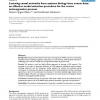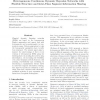515 search results - page 25 / 103 » Subsequence Matching on Structured Time Series Data |
NIPS
1998
13 years 9 months ago
1998
A common way to represent a time series is to divide it into shortduration blocks, each of which is then represented by a set of basis functions. A limitation of this approach, ho...
VLDB
2005
ACM
14 years 1 months ago
2005
ACM
Vehicle tracking data is an essential “raw” material for a broad range of applications such as traffic management and control, routing, and navigation. An important issue with...
PKDD
2007
Springer
14 years 2 months ago
2007
Springer
Abstract. When seeking for small clusters it is very intricate to distinguish between incidental agglomeration of noisy points and true local patterns. We present the PAMALOC algor...
BMCBI
2007
13 years 8 months ago
2007
Background: Causal networks based on the vector autoregressive (VAR) process are a promising statistical tool for modeling regulatory interactions in a cell. However, learning the...
ICML
2010
IEEE
13 years 7 months ago
2010
IEEE
Classical dynamic Bayesian networks (DBNs) are based on the homogeneous Markov assumption and cannot deal with heterogeneity and non-stationarity in temporal processes. Various ap...


